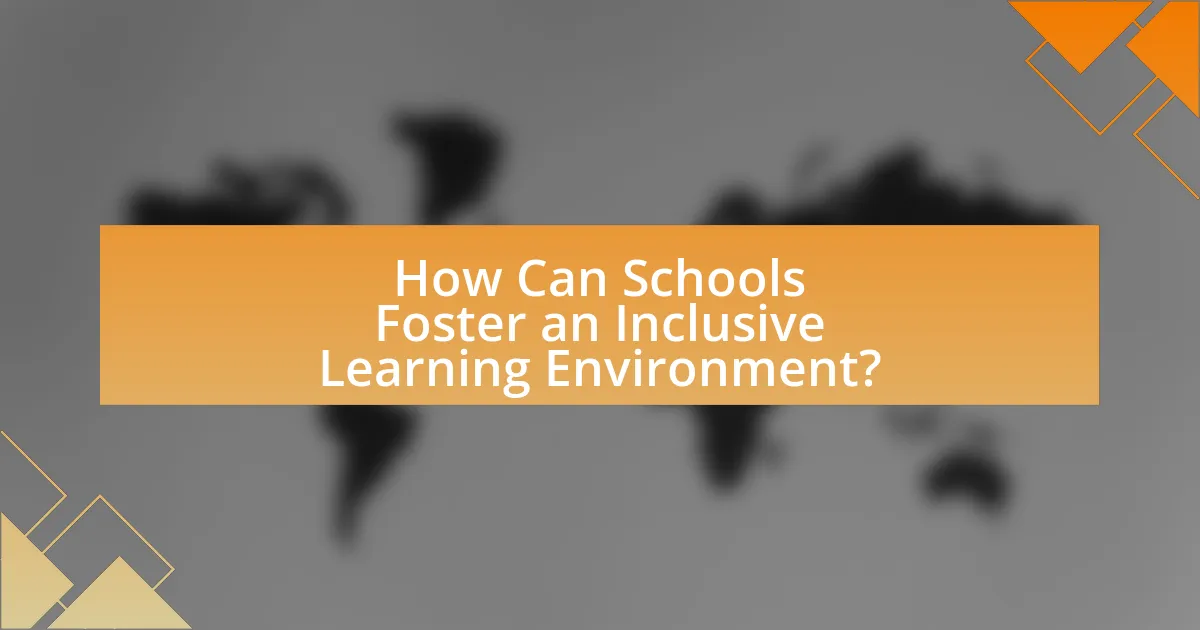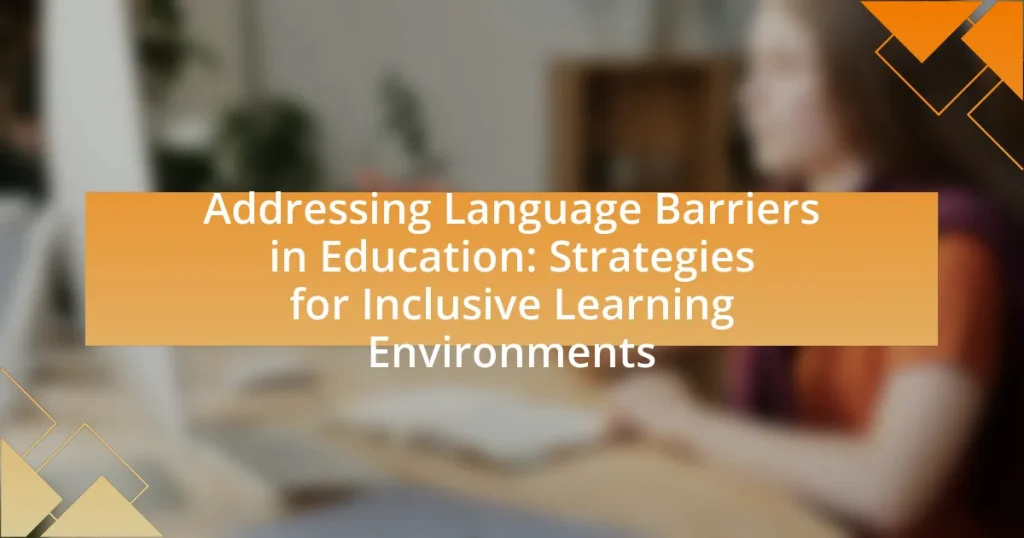Language barriers in education refer to the challenges faced by students and educators when they do not share a common language, which can impede effective communication and learning. Approximately 21% of public school students in the United States speak a language other than English at home, leading to misunderstandings and lower academic performance, particularly among English Language Learners (ELLs). This article explores the impact of language barriers on student learning, the specific challenges faced by non-native speakers, and the importance of addressing these barriers to create inclusive educational environments. It also discusses strategies such as bilingual education, differentiated instruction, and the use of technology to support language acquisition, as well as the role of school culture and family engagement in fostering an inclusive atmosphere for diverse learners.

What are Language Barriers in Education?
Language barriers in education refer to the challenges that arise when students and educators do not share a common language, hindering effective communication and learning. These barriers can lead to misunderstandings, reduced participation, and lower academic performance among students who are non-native speakers or who come from diverse linguistic backgrounds. Research indicates that approximately 21% of public school students in the United States speak a language other than English at home, highlighting the prevalence of this issue. Addressing language barriers is essential for creating inclusive learning environments that support all students’ educational success.
How do language barriers impact student learning?
Language barriers significantly hinder student learning by limiting comprehension and communication in educational settings. When students cannot understand the language of instruction, they struggle to grasp key concepts, participate in discussions, and complete assignments effectively. Research indicates that students who are English Language Learners (ELLs) often experience lower academic performance compared to their peers due to these barriers. For instance, a study by the National Center for Education Statistics found that ELLs are more likely to score below proficient levels in reading and mathematics, highlighting the direct impact of language proficiency on academic achievement.
What specific challenges do non-native speakers face in the classroom?
Non-native speakers face significant challenges in the classroom, primarily due to language proficiency barriers. These barriers can lead to difficulties in understanding instructions, participating in discussions, and comprehending academic content, which can hinder their overall learning experience. Research indicates that non-native speakers often struggle with vocabulary acquisition, grammatical structures, and pronunciation, which can affect their confidence and willingness to engage in classroom activities. For instance, a study by the National Center for Education Statistics found that students with limited English proficiency are at a higher risk of academic underachievement compared to their native-speaking peers. This highlights the need for targeted support and strategies to facilitate their learning and integration into the classroom environment.
How do language barriers affect teacher-student communication?
Language barriers significantly hinder teacher-student communication by creating misunderstandings and limiting the exchange of information. When students and teachers do not share a common language, students may struggle to comprehend instructions, participate in discussions, and express their thoughts or questions effectively. Research indicates that effective communication is crucial for academic success; for instance, a study published in the Journal of Educational Psychology found that students who faced language barriers were more likely to experience lower academic performance and engagement levels. This evidence underscores the importance of addressing language barriers to foster a more inclusive and effective learning environment.
Why is it important to address language barriers in education?
Addressing language barriers in education is crucial because it ensures equitable access to learning opportunities for all students. When language barriers are not addressed, students who are non-native speakers may struggle to understand the curriculum, leading to lower academic performance and increased dropout rates. Research indicates that students who are proficient in the language of instruction perform better academically; for instance, a study by the National Center for Education Statistics found that English language learners who received targeted language support showed significant improvements in their academic outcomes. Therefore, addressing these barriers not only enhances individual student success but also promotes a more inclusive and effective educational environment.
What are the long-term effects of unaddressed language barriers on students?
Unaddressed language barriers in students lead to significant long-term academic and social disadvantages. These barriers can result in lower academic achievement, as students struggle to understand the curriculum and participate in classroom discussions. Research indicates that students with language barriers are more likely to experience lower graduation rates; for instance, a study by the Migration Policy Institute found that English language learners are at a higher risk of dropping out compared to their peers. Additionally, unaddressed language barriers can hinder social integration, leading to feelings of isolation and decreased self-esteem, which can persist into adulthood. This social impact is supported by findings from the American Educational Research Association, which highlight that students who cannot communicate effectively are less likely to form friendships and engage in extracurricular activities, further exacerbating their educational challenges.
How can inclusive education benefit all students?
Inclusive education benefits all students by fostering a diverse learning environment that enhances social skills and academic performance. Research indicates that inclusive classrooms promote collaboration among students of varying abilities, leading to improved communication and empathy. A study published in the Journal of Special Education found that students in inclusive settings showed higher levels of engagement and motivation, which positively impacted their learning outcomes. Furthermore, inclusive education prepares all students for real-world interactions by teaching them to appreciate diversity, ultimately contributing to a more equitable society.

What Strategies Can Be Implemented to Address Language Barriers?
To address language barriers in education, implementing strategies such as bilingual education programs, the use of translation technology, and culturally responsive teaching can be effective. Bilingual education programs allow students to learn in both their native language and the target language, which has been shown to improve academic performance and language proficiency (Thomas & Collier, 2002). Translation technology, including apps and software, facilitates communication between educators and non-native speakers, enhancing understanding and engagement. Culturally responsive teaching recognizes and incorporates students’ cultural backgrounds into the curriculum, fostering an inclusive environment that values diversity and promotes language development. These strategies collectively support effective communication and learning for all students, regardless of their language proficiency.
How can teachers adapt their teaching methods for diverse language needs?
Teachers can adapt their teaching methods for diverse language needs by implementing differentiated instruction, utilizing visual aids, and fostering a supportive classroom environment. Differentiated instruction allows educators to tailor lessons to meet the varying proficiency levels of students, ensuring that all learners can engage with the material effectively. For instance, using visual aids such as charts, images, and videos can enhance comprehension for students who may struggle with language. Additionally, creating a supportive classroom environment encourages collaboration and peer interaction, which can help students practice language skills in a low-pressure setting. Research indicates that these strategies significantly improve language acquisition and academic performance among students with diverse language backgrounds.
What role does differentiated instruction play in overcoming language barriers?
Differentiated instruction plays a crucial role in overcoming language barriers by tailoring educational approaches to meet the diverse linguistic needs of students. This instructional strategy allows educators to modify content, process, and assessment methods based on individual student proficiency levels, learning styles, and interests. For instance, research indicates that when teachers implement differentiated instruction, such as using visual aids and collaborative learning, students with limited language skills show improved comprehension and engagement (Tomlinson, 2001). By addressing varying language abilities, differentiated instruction fosters an inclusive learning environment where all students can access the curriculum effectively.
How can visual aids enhance understanding for language learners?
Visual aids enhance understanding for language learners by providing concrete representations of abstract concepts, which facilitates comprehension. Research indicates that visual aids, such as images, charts, and videos, can improve retention and recall of information by up to 65% compared to text alone. This is particularly beneficial for language learners who may struggle with vocabulary and grammar, as visuals can bridge gaps in understanding and provide context. Additionally, studies show that incorporating visual elements in instruction can cater to diverse learning styles, making lessons more engaging and accessible.
What resources are available to support language learners?
Various resources are available to support language learners, including language learning apps, online courses, tutoring services, and community language exchange programs. Language learning apps like Duolingo and Babbel provide interactive lessons and practice opportunities, while online platforms such as Coursera and edX offer structured courses from universities. Tutoring services, both in-person and online, connect learners with experienced instructors for personalized guidance. Additionally, community language exchange programs facilitate practice with native speakers, enhancing conversational skills. These resources collectively contribute to effective language acquisition and support diverse learning needs.
How can technology be utilized to aid language acquisition?
Technology can be utilized to aid language acquisition through interactive language learning applications and online resources. These tools provide immersive experiences, such as gamified learning, which enhances engagement and retention of new vocabulary and grammar. For instance, platforms like Duolingo and Rosetta Stone use adaptive learning algorithms to tailor lessons to individual user progress, making language learning more effective. Research indicates that learners using technology-based methods show improved language skills compared to traditional methods, with studies demonstrating a 30% increase in vocabulary retention when using interactive apps (Hockly, 2018, “Technology and Language Learning”).
What community resources can schools leverage for language support?
Schools can leverage community resources such as local libraries, language centers, and cultural organizations for language support. Local libraries often provide bilingual books and language learning programs, which can enhance students’ language skills. Language centers may offer tutoring and conversation groups tailored to specific languages, helping students practice and improve their proficiency. Cultural organizations frequently host events and workshops that celebrate diverse languages and cultures, fostering an inclusive environment and providing additional language exposure. These resources collectively contribute to overcoming language barriers and promoting effective communication in educational settings.

How Can Schools Foster an Inclusive Learning Environment?
Schools can foster an inclusive learning environment by implementing differentiated instruction tailored to meet diverse student needs. This approach allows educators to adapt their teaching methods and materials to accommodate various learning styles, abilities, and language proficiencies. Research indicates that differentiated instruction enhances student engagement and achievement, particularly for English language learners, as it provides multiple avenues for understanding and participation. Additionally, schools can promote collaboration among students through group work and peer tutoring, which encourages social interaction and language development. By creating a supportive atmosphere that values diversity and encourages respect, schools can effectively address language barriers and ensure all students feel included and empowered in their learning journey.
What role does school culture play in addressing language barriers?
School culture plays a crucial role in addressing language barriers by fostering an inclusive environment that values linguistic diversity. A positive school culture encourages collaboration among students, teachers, and families, which enhances communication and understanding. Research indicates that schools with strong cultural competence training for staff see improved academic outcomes for English language learners, as these educators are better equipped to support diverse linguistic needs. Furthermore, schools that celebrate multilingualism and provide resources in multiple languages create a sense of belonging, which is essential for student engagement and success.
How can schools promote multilingualism among students?
Schools can promote multilingualism among students by implementing comprehensive language programs that encourage the learning of multiple languages. These programs can include offering diverse language courses, integrating bilingual education models, and fostering a school culture that values linguistic diversity. Research indicates that students who engage in multilingual education demonstrate improved cognitive skills and cultural awareness, which enhances their overall academic performance. For instance, a study by Thomas and Collier (2002) found that students in bilingual programs outperformed their peers in English-only programs on standardized tests. By actively promoting multilingualism, schools can create inclusive learning environments that prepare students for a globalized world.
What training should educators receive to effectively support language learners?
Educators should receive training in culturally responsive teaching, language acquisition theories, and differentiated instruction to effectively support language learners. Culturally responsive teaching equips educators with strategies to connect with diverse student backgrounds, fostering an inclusive environment. Understanding language acquisition theories, such as Krashen’s Input Hypothesis, helps educators recognize the stages of language development, enabling them to tailor instruction accordingly. Additionally, training in differentiated instruction allows educators to modify lessons to meet the varied needs of language learners, ensuring that all students can access the curriculum. Research indicates that these training components significantly enhance the educational outcomes for language learners, as evidenced by studies showing improved academic performance and engagement in multilingual classrooms.
How can collaboration with families enhance language support?
Collaboration with families enhances language support by creating a consistent and enriched language environment for students. When families engage in their children’s language development, they reinforce learning that occurs in educational settings, leading to improved language skills. Research indicates that children whose families are involved in their education demonstrate higher levels of language proficiency and academic achievement. For instance, a study by the Harvard Family Research Project found that family engagement in education positively impacts children’s language development, particularly for those from diverse linguistic backgrounds. This partnership allows educators to tailor language support strategies that align with the cultural and linguistic contexts of the students, further promoting effective communication and learning.
What strategies can schools use to engage non-English speaking parents?
Schools can engage non-English speaking parents by implementing multilingual communication strategies, such as providing translated materials and hiring bilingual staff. Research indicates that effective communication fosters parental involvement, which is crucial for student success. For instance, a study by the National Center for Family & Community Connections with Schools found that schools that actively communicate in parents’ native languages see increased participation in school activities and improved student outcomes. Additionally, organizing community events that celebrate diverse cultures can create a welcoming environment, encouraging non-English speaking parents to engage more with the school community.
How can schools create a welcoming environment for diverse families?
Schools can create a welcoming environment for diverse families by implementing inclusive communication strategies and culturally responsive practices. This includes providing multilingual resources, such as translated materials and interpreters, to ensure that all families can access important information. Research shows that schools with effective communication strategies see increased family engagement, which is crucial for student success. Additionally, schools can host cultural events and workshops that celebrate diversity, fostering a sense of belonging among families from various backgrounds. By actively involving families in decision-making processes and school activities, schools can strengthen community ties and promote inclusivity.
What are some best practices for implementing language support strategies?
Best practices for implementing language support strategies include conducting a thorough needs assessment to identify the specific language requirements of students, providing professional development for educators on culturally responsive teaching, and integrating technology tools that facilitate language learning. Research indicates that schools that utilize targeted assessments can better tailor their language support programs, leading to improved student outcomes. Additionally, training teachers in culturally relevant pedagogy enhances their ability to engage multilingual learners effectively, as shown in studies by the National Center for Education Statistics, which highlight the positive impact of teacher training on student achievement in diverse classrooms.
How can schools measure the effectiveness of their language support initiatives?
Schools can measure the effectiveness of their language support initiatives through standardized assessments, student progress tracking, and feedback from both students and teachers. Standardized assessments, such as language proficiency tests, provide quantifiable data on students’ language skills before and after the implementation of support initiatives, allowing for direct comparisons. Additionally, tracking individual student progress over time through formative assessments and classroom performance can reveal improvements in language acquisition and academic achievement. Feedback from students and teachers can also offer qualitative insights into the perceived effectiveness of the initiatives, highlighting areas of success and opportunities for improvement. Collectively, these methods provide a comprehensive evaluation of language support initiatives’ impact on student learning outcomes.
What common challenges might schools face when addressing language barriers?
Schools commonly face challenges such as insufficient resources, lack of trained staff, and cultural differences when addressing language barriers. Insufficient resources can include limited access to translation services and educational materials in multiple languages, which hinders effective communication. The lack of trained staff, particularly bilingual educators, can impede the ability to provide adequate support for non-native speakers. Additionally, cultural differences may lead to misunderstandings between educators and students or their families, complicating the learning process. These challenges collectively impact the effectiveness of educational strategies aimed at fostering an inclusive learning environment.



